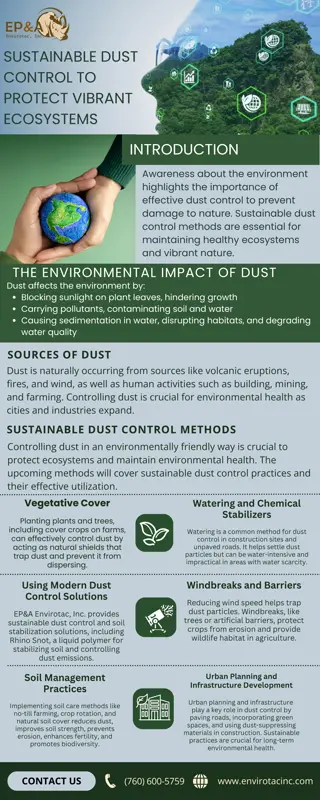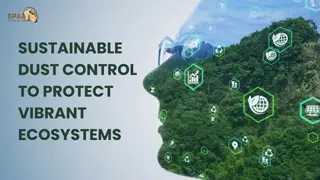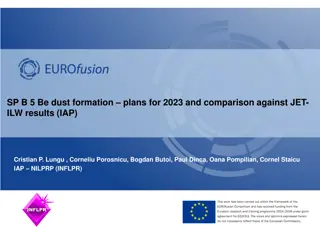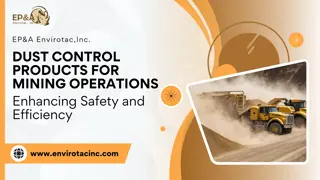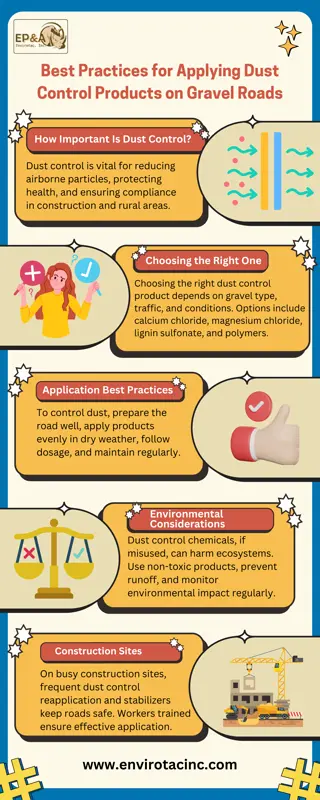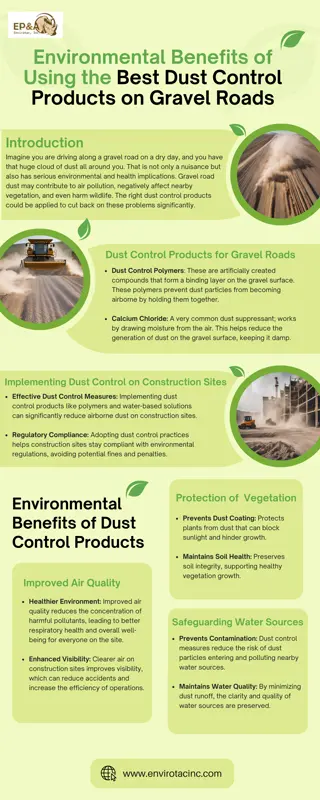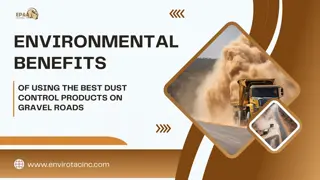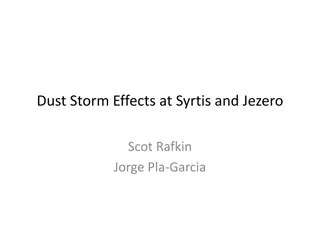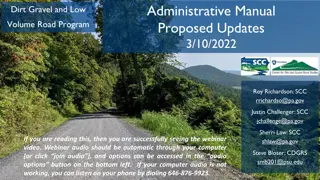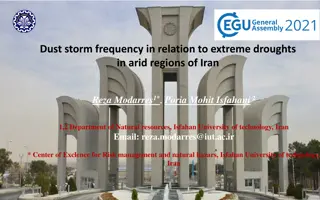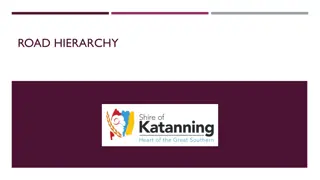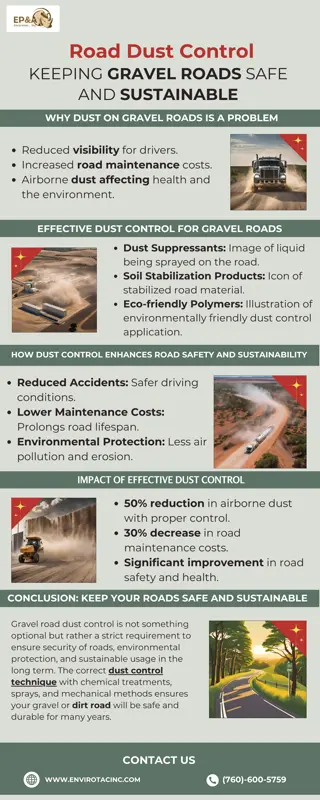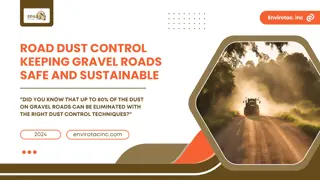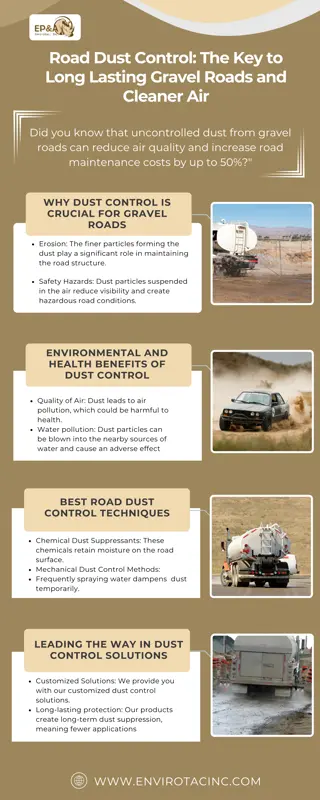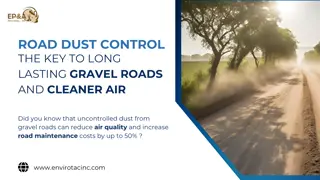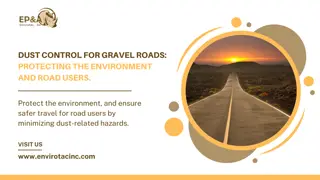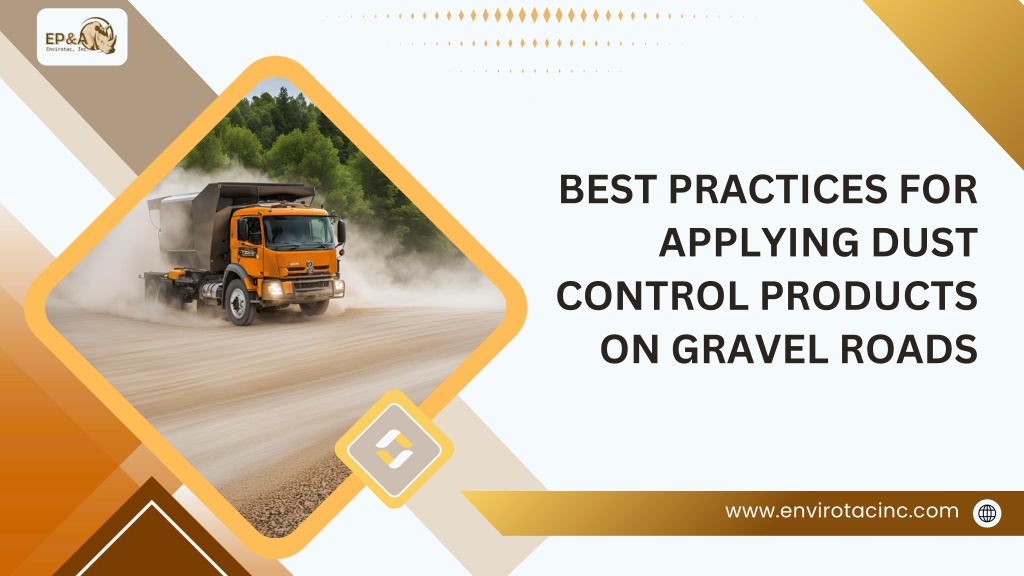
Best Practices for Applying Dust Control Products on Gravel Roads
"Master dust control on gravel roads with top practices for effective application and environmental care, ensuring safe, dust-free surfaces for all users."nn
Download Presentation

Please find below an Image/Link to download the presentation.
The content on the website is provided AS IS for your information and personal use only. It may not be sold, licensed, or shared on other websites without obtaining consent from the author. Download presentation by click this link. If you encounter any issues during the download, it is possible that the publisher has removed the file from their server.
E N D
Presentation Transcript
BEST PRACTICES FOR APPLYING DUST CONTROL PRODUCTS ON GRAVEL ROADS www.envirotacinc.com
PAGE 1 INTRODUCTION Gravel roads are essential in rural communities and building sites, among many other industrial activities. The biggest problem, however, with gravel roads is dust. It may be a critical air quality or visibility problem or wear out vehicle parts in such a way that it increases expenses. Fortunately, dust control products can alleviate these problems and provide a much safer and more efficient environment. The following article is on dust control best practices on gravel roads, looking at effectiveness and environmental responsibility.
PAGE 2 HOW IMPORTANT IS DUST CONTROL? Before getting into best practices, it's always important to know first the importance of dust control. This is because the gravel road particles become airborne and at times travel long distances, therefore affecting not only the immediate surroundings but also the whole community and the ecosystem as a whole. For construction sites, it's a question of compliance with regulatory agencies while protecting the health of your employees. Dust control products bond dust particles to the road surface and minimize their potential to become airborne.
PAGE 3 DUST CONTROL PRODUCTS: CHOOSING THE RIGHT ONE Selection of the right dust control products is only part of the equation for ineffective dust suppression. Indeed, selection has to consider several factors, including the type of gravel, traffic volume, and environmental conditions. Common dust control product types include: CALCIUM CHLORIDE MAGNESIUM CHLORIDE SYNTHETIC POLYMERS LIGNIN SULFONATE This hygroscopic compound absorbs moisture from the air, keeping the road surface damp and effectively controlling dust in dry climates. These man-made compounds create a soft, pliable, resilient crust on road surfaces, aiding soil stabilization and performing well in heavy traffic areas. It attracts moisture like calcium chloride but works better across various conditions with lower corrosiveness, making it preferable in some applications. A by-product of the paper industry, this lignin derivative binds with gravel, acting as a natural binder to keep dust away.
PAGE 4 APPLICATION BEST PRACTICES After the selection of the right material has been made, the application then becomes the second most important factor. Some best practices for the application of dust control products on gravel roads are as follows
APPLICATIONS PAGE 5 SURFACE PREPARATION Proper surface preparation is crucial for dust control effectiveness. Grade and compact the road, ensuring debris removal for even product distribution. APPLICATION TIMING Products for dust control should be applied in fine weather for proper adherence to road surfaces. Avoid applying before rainstorms to prevent washing off. PROPER DOSAGE Follow the manufacturer s dosage to ensure effectiveness and environmental safety, balancing application to avoid waste or harm while controlling dust. EVEN APPLICATION Apply dust control products uniformly to avoid patchy dust formation and reduced effectiveness. Use specialized equipment like sprayers for consistent application.
PAGE 6 REAPPLICATION AND MAINTENANCE Dust control is never a one-time solution. For long-term efficacy, periodic maintenance and reapplication are required. Monitor the road surface frequently after heavy use or bad weather and reapply the product as needs dictate.
PAGE 7 ENVIRONMENTAL CONSIDERATIONS Dust control products should be used with a lot of sensitivity toward the surroundings. Some are corrosive, such as calcium chloride and magnesium chloride. The chemicals can be harmful to vegetation and sources of water in the event of misuse in the area. Follow the best environmental management practices such as safeguarding this occurrence and mitigating it as much as one can. USE NON-TOXIC PRODUCT Wherever possible, employ biodegradable or minimally toxic dust control products. For example, synthetic polymers are formulated to harbor minimal risk of harm to the nearby ecosystem. PREVENT RUNOFF Prevent runoff of treated roads to adjacent water bodies. This can include creating barriers or ditches to direct water away from sensitive areas. IMPACT MONITORING Check periodically around the treated gravel roads for a sign of environmental impact. It could be anything from vegetation damage to changes in soil composition and water contamination.
PAGE 8 SPECIFIC EMPLOYMENT: CONSTRUCTION SITES AND HIGH-TRAFFIC AREAS On construction sites and in areas of high traffic, dust control is critical. Some additional tips for these situations include: FREQUENT REAPPLICATION Since the construction sites usually have a huge amount of vehicle traffic, there is more dust raised. This calls for the need to keep reapplying the dust control products to keep the place clean. STABILIZERS: Utilize dust control products that are going to stabilize high-volume traffic areas. This will not only control dust but will stabilize the road surface and eliminate frequent grading and maintenance. IMPROVED RESOURCE ALLOCATION Ensure that workers are properly informed on the dust control measures to be adopted and that they are trained for the safe and effective application of products. Worker safety shall at all cost be guaranteed, more so within the construction environment.
THANK YOUR FOR YOUR ATTENTION CONTACT US FOR MORE INFORMATION www.envirotacinc.com (760) 600-5759


